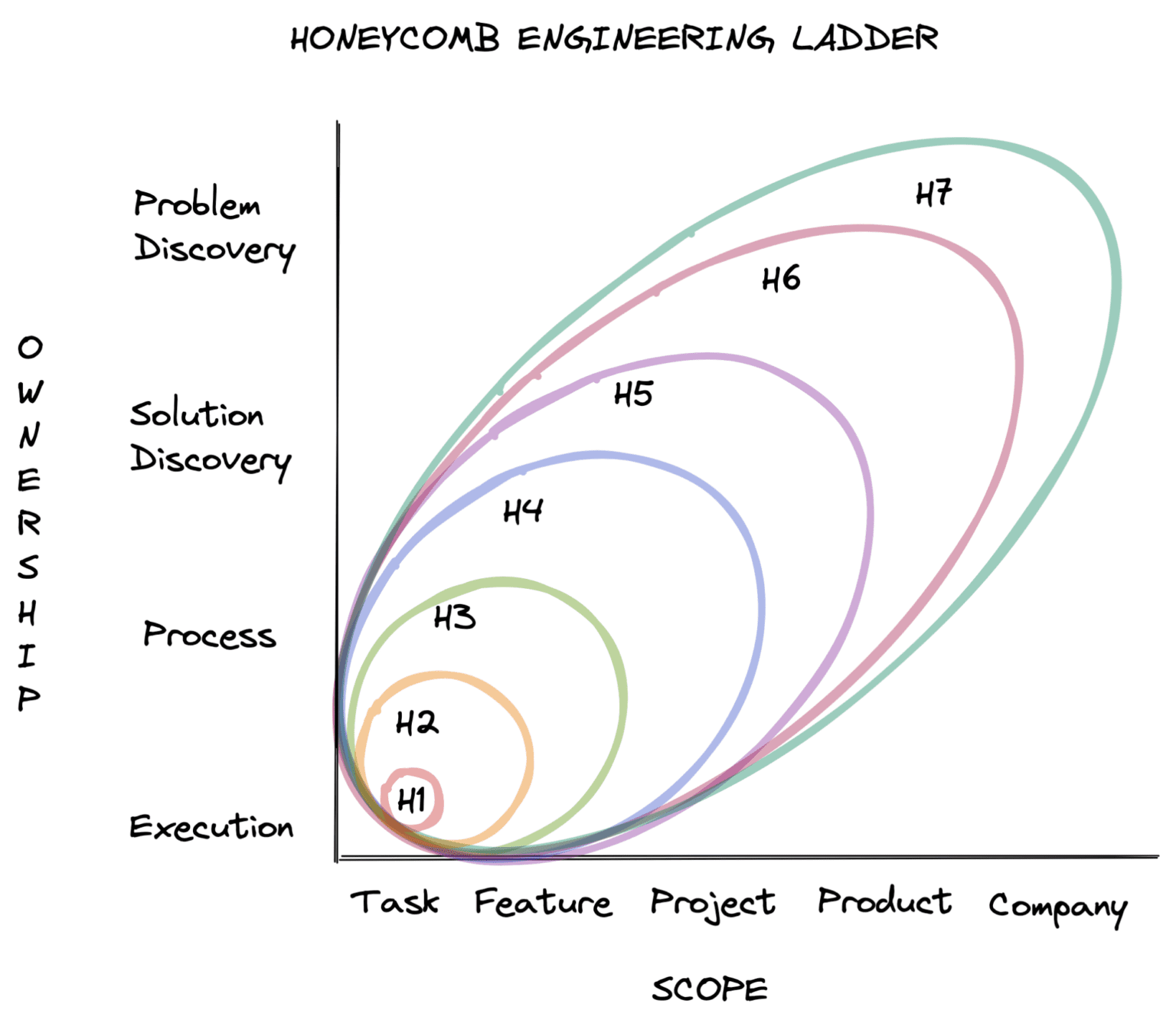Engineering Levels at Honeycomb: Avoiding the Scope Trap
It has been seven years since Rent the Runway posted their engineering ladder, kicking off a veritable trend of engineering teams open sourcing their ladders. Interestingly, nearly all of them seem to have coalesced…

By: Ben Darfler

It has been seven years since Rent the Runway posted their engineering ladder, kicking off a veritable trend of engineering teams open sourcing their ladders. Interestingly, nearly all of them seem to have coalesced around “area of scope” as a useful proxy for level.
At first glance, “area of scope” does seem to make sense. Senior engineers should be able to work across larger areas of the organization. In addition, your area of influence should expand as you gain experience. Yet, there is an unfortunate shadow side to this approach: a ladder that conflates advancement with scope is a ladder that only rewards engineers who work on the largest projects. This doesn’t seem fair.
There are times when broad scope may be unavoidable, but at Honeycomb, we try to cultivate a healthy skepticism toward scope. More often than not, scope is the enemy. We would rather reward engineers who find clever ways to limit scope by decomposing problems in both time and size. We also want to reward engineers who work on the most important problems for the business, regardless of the size of the project. We don’t want to reward people for gaming out their work based on what will get them promoted.
With this in mind, what should our ladder use instead of scope? As all good experiments do here at the Hive, we set out on a journey of discovery.
Evaluating our old ladder
Many companies view building a job ladder as management’s task, but as you might have guessed, that’s not how we roll here at Honeycomb. A job ladder is a formal expression of a company’s values and culture, and engineers should be just as invested in it as managers. So the first thing we set out to do was ask everyone to weigh in on our old ladder. Instantly, some common themes emerged.
- Our engineers want our job ladder to reflect and incorporate our company values more closely. (1. Fast and close to right is better than perfect, 2. We hire adults. 3. Everything’s an experiment. 4. Feedback is a gift.)
- Finding the right level of abstraction/specificity is hard. We need to be specific enough to guide engineers towards the next level yet apply to many differently shaped engineers (SRE, FE, Security, Telemetry, etc.), especially as we move away from being a team of full stack generalists.
- There are problems that come with tying promotion to scope size and the perverse incentives it creates.
The PSHE framework
While talking about scope, one of our Staff Engineers, Max Edmands, suggested we look at the PSHE framework. PSHE (problem, solution, how, and execution) came from YouTube’s product team when they grappled with this very same problem, promotions tied to scope. This drove them to add a second dimension to their career ladder, which they called PSHE (others have identified similar progressions such as Implementers, Solvers, and Finders). In both cases, the insight gleaned is that career progression happens over wider areas of both scope and ownership.
- Scope progresses from focusing on tasks to features to projects, products, and the company as a whole.
- Ownership progresses from focusing on the execution of work to the process of delivering work, to the discovery of solutions to deliver, to the discovery of problems to solve.
Using this, we drafted a new version of the ladder that includes both ownership and scope and then opened a request for comment. Once we solicited feedback from everyone in engineering, we made some final adjustments and adopted the revised version just in time for our mid-year review cycle.
The engineering job ladder v2
So at this point, you might be thinking to yourself, “well, that’s a bunch of pretty talk about processes, but where is the damn ladder?” Fair question and I’m very sorry to get your hopes up, but we aren’t open sourcing our own ladder just yet. Primarily because we hacked it together rather slap-dashily, with copy-paste from other organizations. Therefore, we will have to get all the copyright and attribution issues sorted out before sharing. More to come!
But, to serve as a preview, we have two valuable tools to share that were helpful to us when recreating our job ladder. In addition to scope and ownership, another theme from our conversations was that our new ladder should be more visual, less “wall-o’-text,” which led us to make the two diagram illustrations below.
Tool #1: Engineering ladder diagram
Some aspects of our ladder may be familiar to you, like how the gap between levels increases as you move up the ladder. “Senior engineer” (H5) is a “terminal level” for us, which sounds extreme, but it just means “you don’t have to advance beyond this level.” While our ladder continues above the senior level, many very talented engineers stay at H5 because they are happy and still create the impact at Honeycomb that leaves them fulfilled. But for engineers at lower levels, there is an expectation of growth rooted in the support, coaching, mentorship, and sponsorship to realize their growth potential.
We also recognize that going from Senior to Staff engineer is a phase shift. As many reading this blog know, this is a topic of discussion in the engineering world, but one we believe is a concept that fits our culture here at Honeycomb. While many of these ideas are becoming standard, it can be a lot to take in if you aren’t familiar with the different pieces. To make this more intuitive, we made the following diagram. It conveys everything normally derived from the traditional wall of text to a single glance.

Tool #2: Growth framework based on scope & ownership
The other visualization depicts our new growth framework based on scope and ownership. We wanted to communicate that each level on the ladder is a superset of the previous levels and that there are a variety of ways to operate at any given level.

For example, someone might operate at a higher level of ownership in a smaller scope or at a smaller level of ownership at a larger scope, or somewhere in between. Of course, there is value in growing in both dimensions, but it is more common to stretch in one direction or the other at any given point.
Want to work at Honeycomb?
These new and improved ladders, imbued with our values and built on a framework of scope and ownership, have set us up for the next level of our growth within the engineering team here at Honeycomb.
If how we designed our new job ladder resonates with you, we are hiring and would love to talk! And, if you end up borrowing any parts of this for your own ladder, we’d LOVE to hear about it in the Slack Pollinators group (you just need a free honeycomb account). Or send us a Tweet (@honeycombio) and let us know how it goes for your organization.
Want to know more?
Talk to our team to arrange a custom demo or for help finding the right plan.